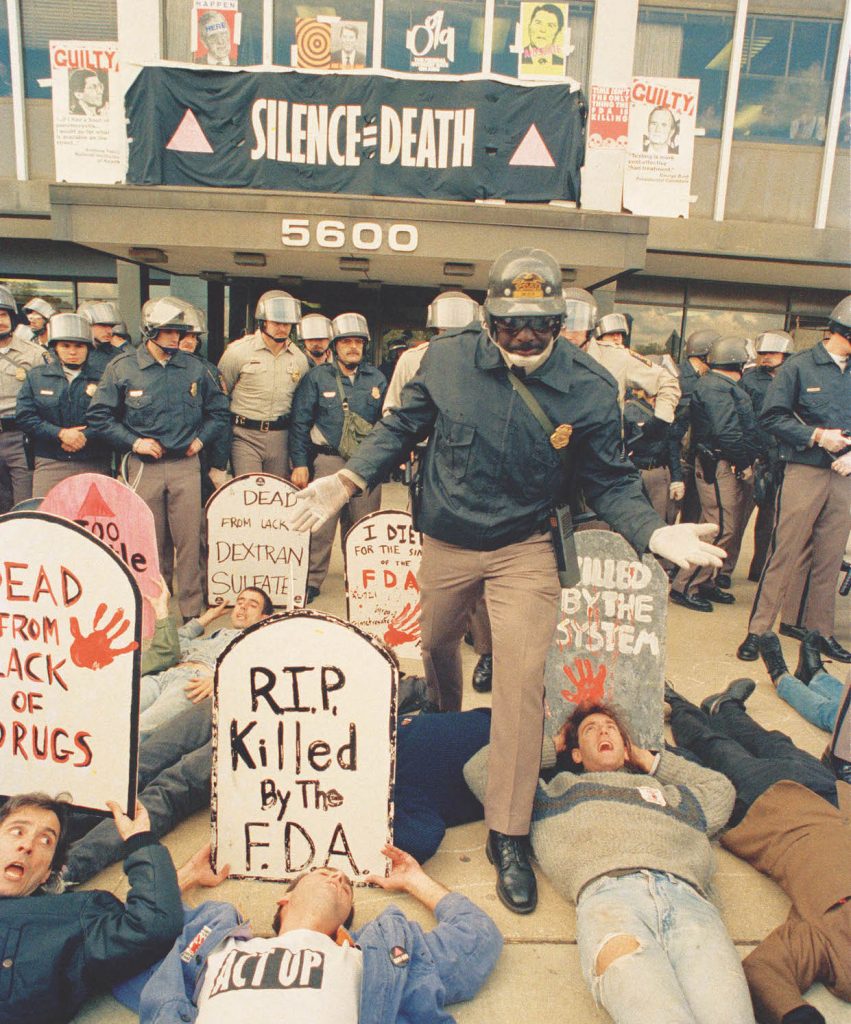This review appears in our Fall 2021 issue. Subscribe now to receive a copy in your mailbox.
Discussed in this essay: Let the Record Show: A Political History of ACT UP New York, 1987-1993, by Sarah Schulman. Farrar, Straus and Giroux, 2021. 736 pages.
EVEN BEFORE AIDS, patriarchy has made an association between queers and plague. In the West, we are a disease on the social, an illness to be cured and purged from a healthy body politic. At its best, queerness promises porous, polymorphous perversities, a refusal to submit to proper relations beyond consenting desire. No wonder, then, that in the eyes of the bosses, fathers, priests, cops, and their allies, we threaten to pull the entire world with us into a decadent morass of pleasure, joy, laziness, and freedom. That is why the places they’ve dealt with us homosexuals, transsexuals, interssexuals and the like have so often been medical: the surgeon’s clinic, the analyst’s couch, the psychiatrist’s asylum, the conversionist’s camp. Is it any surprise, a year-and-a-half into this plague, that the forces of political reaction have seen fit to attack the ongoing uprising by attacking trans life, attempting to legislate us out of existence in the name of “medical” concern for children?
In light of all this, it is exactly the right time for a righteous and powerful history of queer resistance, AIDS, plague, and struggle. So it is no wonder that excitement for Sarah Schulman’s Let the Record Show: A Political History of ACT UP New York, 1987-1993, which bills itself as such a history—the “most comprehensive political history ever” of the activist group, according to the back cover—far outweighs that which would usually accompany the release of a movement history doorstop. Over a decade in the making, the 650-page account is based on extensive oral histories as well as Schulman’s own experience. The book is a pleasant and easy read, almost chatty, driven by the voices of the interviewees, whose names often appear as section headings, and full of the emotions, memories, and sometimes contradictory claims of its subjects; as a result, it is much less dry than many other modes of historical narrative, without feeling any less serious. Through this multivocal approach, the book traces the roots, accomplishments, conflicts, and partial collapse of ACT UP New York at the zenith of the movement’s power and prominence.
I lost the only out queer member of my family, my uncle Roger Hulley, to AIDS in 1997, long before I was out even to myself; the grief of that loss has rippled through my life, my mother’s, my brother’s. Versions of this grief have reverberated, personally and communally, through several decades of queer life, registering a lost generation of elders and a horrifying rupture in our social and political history—to say nothing of the ongoing AIDS crisis which, now that it has largely stopped killing rich cis white men in the US, is no longer understood as such. I am desperate to learn from the struggles, perspectives, and feelings of those who lived and fought in grim but also joyful resistance during those apocalyptic years. I want a book that earns and embodies an opening like Schulman’s, which begins, “This is a book in which all people with acquired immune deficiency syndrome (AIDS) or with the human immunodeficiency virus (HIV) are equally important.” How painful, then, to be a trans person reading and reviewing this book, and to encounter yet another work of trans erasure claiming to be the history of queer resistance.
Much of the research that has been done to create this book is invaluable. Schulman has structured the volume around 188 interviews with surviving members of the New York City chapter of the AIDS Coalition to Unleash Power, better known as ACT UP. She and documentarian Jim Hubbard conducted these interviews between 2001 and 2018 as part of the ACT UP Oral History project they spearheaded. When we study the history of movements, we often look to the most spectacular moments of protest or conflict as hinge points, but smaller forms of action and organizing, often inspired by the major actions but irreducible to them, are just as important. Schulman at times recognizes this, focusing on crucial aspects of ACT UP’s ongoing legacy, like its needle exchange program or its activist-led medical research—initiatives a less capacious interview process might have easily missed. In an equally important move, Schulman and Hubbard have made the full transcripts of those interviews free and available to the public online. The value of this incredible feat of activist archivism—especially for an organization that included so many members who died young—cannot be overstated.
But the importance of that oral history project cannot overcome the intrinsic weaknesses of that archive. The survivors tell the tale, and—as Schulman points out throughout the book, survival in the AIDS crisis was heavily skewed towards cis white gay men with access to legal, media, financial, and scientific resources. Therefore any record given mostly by activists who survived into the 2000s will overrepresent those men, especially in an organization where they already made up a disproportionate percentage of the activist base. And memory is also unreliable, as we continue to learn and grow, and certain attitudes, analyses, and experiences calcify into particular, often self-flattering narratives.

October 11th, 1988. Photo: J. Scott Applewhite/AP Photo
Thus the importance of supplementing the post-movement accounts of participants, especially those given decades later, with other kinds of historical evidence: more immediate records, propaganda, and writing produced by participants, journalists, and government researchers, as well as secondary sources produced by academics or historians who employ different analytic modes. The other major well of information in the book, however, is Schulman herself: memories from her own participation in ACT UP NYC, as well as her own research and journalism. This rather vague and narrow lens allows Schulman to dismiss controversies around gender, race, and strategy that have arisen in the years since ACT UP’s heyday, even as she claims that her more immediate and personal account of the movement should serve as a corrective to others. Her preface catalogues some of the ways she sees AIDS as having been “grossly misrepresented and mis-historicized,” from the New York Times’ infamous underreporting of the epidemic to the 2012 ACT UP documentary How to Survive a Plague’s “heroic white male individual model” for understanding AIDS activism. Even the book’s title, Let The Record Show, positions her book as a quasi-legalistic account of the real truth.
Of course, every historical narrative has a frame, every writer of history must make choices, and at points, to her credit, Schulman is explicit about the necessary limitations of her approach. But it feels like she acknowledges these limitations in order to preempt critique rather than to allow them to meaningfully change her narrative or method. Take, for instance, this telling juxtaposition. In her preface, Schulman notes, “Black gay men in the U.S. South have rates of HIV infection larger than in any country in the world. . . . AIDS was only over for white males who could access the standard of care, in a nation with no logical health system.” But less than 50 pages later, the introduction features the section heading, “How A Predominantly White Male Organization Won the Movement’s Single Greatest Victory for Women, People of Color, and Poor People.” If people of color and poor people continue to suffer under a largely invisibilized and unspoken AIDS crisis, is this a victory that should be enthusiastically celebrated? What meaning is conveyed, and what critiques elided, by the superlative “greatest”?
This contradiction gets to the heart of the book’s desires. Schulman, as a participant in ACT UP, wants to believe that “AIDS activism was, perhaps, the most recent successful social movement in America.” Her introduction is titled “How Change is Made,” and the book argues that the ACT UP model—nonviolent civil disobedience, inside-outside strategic positioning (protesting and causing ruckus while also having people work within power structures), a single-issue focus, and research-and-information-driven citizen lobbying efforts—is the best way to “make change.” She wants to defend a particular story of ACT UP, and in her defensive posture—informed no doubt by the tragedy of those years, an earnest desire to see her beloved comrades documented, and simple nostalgia—she fails to sufficiently criticize or think through ACT UP’s limits. As a result, Let the Record Show ends up symptomatically reproducing the very exclusions, failures, and violences—in particular transphobic and anti-Black ones—that an actually fearless history might recognize as one important basis for understanding ACT UP’s legacy.
ON DECEMBER 10TH, 1989, in one of ACT UP’s most famous actions, activists disrupted a mass given by New York City cardinal John O’Connor at St. Patrick’s Cathedral, the city’s most iconic Catholic building. Their goal was to draw attention to the undue governmental power of the Catholic Church and its opposition to safe sex education and condom distribution. Schulman traces the planning stages and internal debates around how far the action should go, and demonstrates the powerful effects it had on local policy and social attitudes. The chapter devoted to this important moment in activist history also features the only section in the book focused on trans women as a group. I quote it here in full:
TRANS WOMEN AT STOP THE CHURCH
Interestingly, in an episode that aired in 2019, the television series Pose, produced by Ryan Murphy and Janet Mock, depicted ACT UP’s action at St. Patrick’s Cathedral but added Black trans characters from the series going to the demonstration, performing civil disobedience, and being taken away by the police. In reality, one trans woman was arrested at St. Patrick’s, but they were white: ACT UP facilitator Kathy Otter (later Ottersten). Writing on the ACT UP Alumni Facebook page, Robert Vázquez-Pacheco and Moisés Agosto-Rosario both expressed anger that corporate representations of ACT UP inserted nonexistent people of color while ignoring the people of color who actually were there and did the work. Once again, ACT UP still had no control over its own representation, but this was 2019, thirty-two years after its founding.
My first response to this passage was shock and rage: “Maybe this is so, but surely she can see how transphobic this first appearance of trans women in the book is, where trans women are once again cast primarily as interlopers, recuperators, deceivers.” Then I wondered: Did she research this data point beyond the Facebook thread? It’s not as though arrest records historically represent Black trans people’s genders accurately. How does she know? There is no footnote or further evidence offered. Black trans women only appear in the book insofar as Schulman can insist upon their absence in the movement; that she puts this transphobic critique in the mouths of nonwhite ACT UP members made me feel queasy. This unease led me down the path of questioning the entire book’s methodology: What else was being missed, left out, silenced through this process that I wasn’t particularly attuned to catch?
Black trans women only appear in the book insofar as Schulman can insist upon their absence in the movement.
It’s exhausting to have to pick over a single paragraph in a massive book like this. It’s no fun to be a killjoy, to be distrustful, fearful, and angry. I would be more inclined to trust Schulman’s account if there was any other significant mention of trans women in the book, but only one out trans woman, Kathy Ottersten, appears as an interview subject (she is quoted briefly about her role in ACT UP’s needle exchange program, for which she and several other activists were arrested and placed on trial). Most infuriating of all, Schulman’s chapter “Changing the Definition: Women Don’t Get AIDS, We Just Die from It” contains not a single mention of trans women, nor of trans people of any gender. Some definitions, apparently, do not need to be changed.
This silence on trans women is contrasted with a refrain, repeated throughout the book, about the strategic value of having cis white men willing to do both advocacy and direct action. “AIDS only got addressed at all because white men with access had it,” Schulman writes. Her argument relies on the claim that the overrepresentation of these men in ACT UP strengthened the organization, because of the entrée this stratum of activists had to boardrooms, academic institutions, and relationships with government ministers (including Anthony Fauci, who began his tenure as director of the National Institute of Allergy and Infectious Diseases (NIAID) in 1984 and was thus a key government decision-maker about AIDS research and treatment). This point leads inevitably to distortions of the actual role race and class played in the movement. While she laments the fact that only the spectacle of white men suffering and getting arrested attracted the interest of the press, she also seems resigned to this state of affairs as an unchangeable reality that could be strategically leveraged. She refuses to accept that wealthy cis gay men’s dominance in the movement might have also been a contributing factor in ACT UP’s deterioration once their own treatment was assured. Instead, she describes the betrayal of the particular white men in the research group that broke off into the Treatment Action Group (TAG) in the early 1990s, which helped end ACT UP’s momentum.
A similar pattern is at work when Schulman considers the large-scale aftermath of these developments. She writes honestly, for instance, about how drug companies opportunistically used the movement to weaken the FDA and lower drug-approval standards, which helped lead to horrific pharmaceutical abuses (including, we might add, both the opioid crisis and Covid vaccine apartheid). But here she effectively throws up her hands, writing that “while advocates were able, in a sense, to beat HIV, they could not beat capitalism. And so, today, because of the greed of international pharmaceutical companies and various health industries, large numbers of people with HIV in the United States and around the world cannot receive medications that already exist.” Needless to say, it is not those activists’ fault that they were unable to destroy capitalism. But more broadly speaking, if ACT UP’s model of activism was unable to truly transform the lives of people suffering from AIDS, then why should it be the one adopted by activists today?
If ACT UP’s model of activism was unable to truly transform the lives of people suffering from AIDS, then why should it be the one adopted by activists today?
At the most sweeping level of her analysis, Schulman wants to argue that what made ACT UP successful was its singular approach to bottom-up politics. But ironically, this model—in which activists perform nonviolent media-focused civil disobedience and then leverage the media attention to get a hearing from governments and corporations—should be familiar to anyone who has interacted with an activist nonprofit or leftist formation in the intervening decades. Nonviolent single-issue demonstration-and-research-driven campaigning has become the dominant paradigm of a large swath of political activist organizations, from single-issue nonprofits to some so-called revolutionary organizations, one that has proven again and again to be ineffective in the face of an increasingly carceral state and unequal global capitalism. You could argue that the persistence of this model in well-funded activist groups today reflects capitalist recognition that symbolic, nonviolent campaigns are easily ignored when inconvenient, and equally useful to astroturf desirable reforms for capitalists when helpful.
Schulman’s theory of change, despite the multivocal subject and form of this book, is ultimately quite pessimistic about the possibility of mass movement. In the book’s preface, she writes, “My perception is that the fate of a society is determined by very small groups of people. Only tiny vanguards actually take the actions necessary, and even fewer do this with a commitment to being effective.” Later, she sarcastically discusses the notion that Larry Kramer, the well-known playwright and AIDS activist, was the singular leader of ACT UP. But when it comes time to make her counterargument, she damns with faint praise: “Everyone else [other than the leaders] in ACT UP was just as necessary because they were, on some level, implementers. They did not have the big visions, the original ideas, the innovative approaches, but they cooperated.” If masses of regular people can’t make change, if even most activists are simply following instructions and inspiration set by the revolutionary greats, then perhaps there is no more democratic or effective form of organization than the ACT UP model. But you hardly need a commitment to Marxist class analysis to see that the leap from a historical theory of a handful of Great Men to Schulman’s hundred or so Great People is a numerical distinction without a conceptual difference.
What is movement history for? Too often activists want it to offer a blueprint, a strategic lodestone for further activism. But movement history can also work to introduce us to the comrades we could otherwise never know, to show us the continuities of oppression and struggle, to suggest tactical innovations in discovering and attacking weak points, and to imagine fearless ways of fighting and living that might inspire us to similar fearlessness. Movement history can correct dominant narratives so as to re-center the role of the oppressed in the positive changes in our history, and see the role resistance and rebellion have had in forcing the hands of the powerful. But for me, we don’t study them because we simply want to repeat the movements of the past—which have, after all, not won the liberation we so crave—but to embrace and improve upon tactics and movements as they appear in the present.
I so badly want the book Schulman set out to write. But as the year anniversary of the flames of the George Floyd uprising recedes, Schulman’s hyperbolic enthusiasm for ACT UP’s organizational forms seems less relevant than ever before. The book offers its readers valuable glimpses into an important moment of queer struggle and history. But its incredibly loud silence on trans lives and activism, and its focus on ACT UP as an organizational model to be emulated, might lead just as many astray.
Vicky Osterweil is a writer, editor, and agitator based in Philadelphia. Her book In Defense of Looting: A Riotous History of Uncivil Action was released in 2020 by Bold Type Books.
The post What the Record Doesn’t Show appeared first on Jewish Currents.




